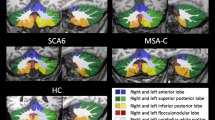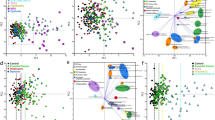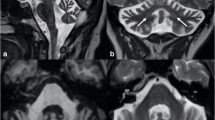Abstract
Signs of atrophy on cranial CT were investigated in 35 patients diagnosed as suffering from autosomal dominant (n=21) or idiopathic (n=14) cerebellar ataxia. Thirteen patients with a pure cerebellar syndrome were examined after at least 4 years of disease (mean duration 10.5 years) and were classified as cerebellar atrophy (CA). Twenty-two patients with additional non-cerebellar signs were classified as olivo-ponto-cerebellar atrophy (OPCA). Four (30%) of the patients with CA had atrophy of the brain stem in addition. Of the 22 patients with OPCA, 9 (40%) had atrophy of the cerebellum only. In patients with CA or OPCA correlation of clinical signs with severity of atrophy on CT was poor. Atrophy on CT often fails to differentiate autosomal dominant or idiopathic cerebellar ataxias in CA or OPCA: patients with CA can also have atrophy of the brain stem and patients with OPCA do not necessarily show brain stem atrophy.
Similar content being viewed by others
References
Eadie MJ (1975) Cerebello-olivary atrophy (Holmes type). In: Vinken PJ, Bruyn GW (eds) Handbook of clinical neurology, vol 21. North-Holland, Amsterdam, pp 403–414
Harding AE (1984) The hereditary ataxias and related disorders. Churchill Livingstone, Edinburgh
Duvoisin RC, Plaitakis A (1984) The olivopontocerebellar atrophies. Raven Press, New York
Wessel K (1989) Degenerative Kleinhirnerkrankungen: Klinik, Neurophysiologie, CT-Morphologie, Verlauf und Therapeutische Ansätze. Habilitationsschrift, Lübeck
Klockgether T, Schroth G, Diener HC, Dichgans J (1990) Idiopathic cerebellar ataxia of late onset: natural history and MRI morphology. J. Neurol Neurosurg Psychiatry 53:297–305
Rothman SLG, Glanz S (1978) Cerebellar atrophy: the differential diagnosis by computerized tomography. Neuroradiology 16: 123–126
Savoiardo M, Bracchi M, Passerini A, Visciani A, Di Donato S, Cochini F (1983) Computed tomography of olivopontocerebellar degeneration. AJNR 4:509–512
Huang YP, Plaitakis A (1984) Morphological changes of olivopontocerebellar atrophy in computed tomography and comments on its pathogenesis. In: Duvoisin RC, Plaitakis A (eds) The olivopontocerebellar atrophies. Raven Press, New York, pp 39–85
Staal A, Meerwaldt JD, Dongen KJ van, Mulder PGH, Busch HFM (1990) Non-familial degenerative disease and atrophy of brainstem and cerebellum. Clinical and CT data in 47 patients. J Neurol Sci 95:259–269
Wessel K, Huss GP, Kömpf D (1992) Die Bedeutung von Neurophysiologie und Computertomographie für die Diagnose zerebellärer Ataxien mit spätem Erkrankungsbeginn. Nervenarzt 63: 95–100
Netzky MG (1968) Degenerations of the cerebellum and its pathways. In: Minckler J (ed) Pathology of the nervous system. McGraw-Hill, New York, pp 1163–1185
Rossini PM, Cracco JB (1987) Somatosensory and brainstem auditory evoked potentials in neurodegenerative system disorders. Eur Neurol 26:176–188
Andreula CF, Camicia M, Lorusso A, D'Aprile P, Federico F, Brindicci D, Carella A (1984) Clinical and CT parameters in degenerative cerebellar atrophy in aged patients. Neuroradiology 26:29–30
Diener HC, Müller A, Thron A, Poremba M, Dichgans J, Rapp H (1986) Correlation of clinical signs with CT findings in patients with cerebellar disease. J Neurol 233:5–12
Klockgether T, Faiss J, Poremba M, Dichgans J (1990) The development of infratentorial atrophy in patients with idiopathic cerebellar ataxia of late onset: a CT study. J Neurol 237:420–423
Wessel K, Schroth G, Diener HC, Müller-Forell W, Dichgans J (1989) Significance of MRI-confirmed atrophy of the cranial spinal cord in Friedreich's ataxia. Eur Arch Psychiatry Neurol Sci 238:225–230
Author information
Authors and Affiliations
Rights and permissions
About this article
Cite this article
Wittkämper, A., Wessel, K. & Brückmann, H. CT in autosomal dominant and idiopathic cerebellar ataxia. Neuroradiology 35, 520–524 (1993). https://doi.org/10.1007/BF00588712
Received:
Revised:
Published:
Issue Date:
DOI: https://doi.org/10.1007/BF00588712




